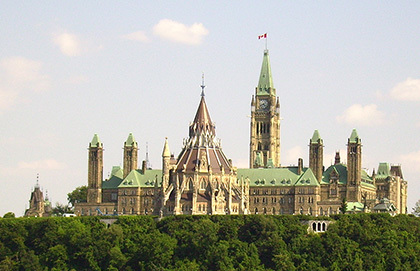On November 2, 2017 the Supreme Court of Canada released its long-awaited decision in Ktunaxa Nation Council et al. v. Minister of Forests, Lands and Natural Resource Operations, 2017 SCC 54. The Supreme Court’s decision ended a 20-year dispute between the Ktunaxa Nation and the federal government.
Glacier Resorts, a private resort corporation, has been attempting to build a ski resort in the Jumbo Valley in British Columbia on a plot of Crown land for more than two decades. The Ktunaxa Nation view that area of land, which they call Qat’muk, as being central to their spiritual connection with the Grizzly Bear Spirit. To build a ski resort on that particular plot of land would, they say, desecrate it and destroy their relationship with the Grizzly Bear Spirit.
The Minister of Forests, Lands and Natural Resources Operations approved the development of the lands and the Ktunaxa Nation brought an application for judicial review of the Minister’s decision, arguing that the decision violated their 2(a) Charter right to religious freedom and the government’s duty to consult and accommodate under section 35 of the Constitution.
The application judge concluded section 2(a) of the Charter did not include a right to restrict otherwise lawful use of lands on the basis that it would interfere with one’s freedom of religion, and that the consultation and accommodation process was reasonable. The Court of Appeal for British Columbia dismissed the appeal.
This was the first time the Supreme Court of Canada heard a case involving a religious freedom claim made by an aboriginal group. One of the issues the Supreme Court was required to consider was whether section 2(a) includes a right to prevent others from engaging in certain activities. Another issue was whether a person’s 2(a) rights are diminished if their exercise of them has any impact on third parties.
In that case, I acted for the Evangelical Fellowship of Canada and Christian Legal Fellowship who jointly intervened. Our interest was in the development of the law surrounding religious freedom, not in the development or land in question. Our focus was in making two separate but related arguments. We argued that (1) the Charter right to religious freedom is not limited to protecting private religious beliefs and practice; and, (2) state interference with the means or vehicles through which religious individuals practice their faith is equivalent to direct interference with their religious practice. Our arguments were partially accepted by the Court.
The Court split its decision 7/2, but both sets of reasons rejected the Ktunaxa’s appeal.
The majority found that the Minister had erred in failing to acknowledge and consider the Ktunaxa’s religious freedom claim, but ultimately concluded that the error was immaterial since the Ktunaxa’s religious freedom claim failed to fall within the scope of the Charter’s freedom of religion protection. In contrast, the minority concurring reasons found that the Ktunaxa’s religious claim was protected, that its religious beliefs and practices were seriously violated, but that the Minister had reasonably balanced the Ktunaxa’s religious freedom claim with its statutory objective to administer Crown land and dispose of it in the public interest.
The good of the decision
If you’re the Ktunaxa people, the decision as a whole is bad, but if you’re simply concerned about the state of religious freedom in Canada, there is some good here.
First, the entire Court affirmed that religious freedom claims must be considered by State actors. It is not sufficient for State actor to simply take the position that religious freedom is not affected by any particular action.
Second, in looking at the minority concurring reasons, they appear to have accepted, albeit in different language, the arguments being put forward by my clients. We argued that for the Ktunaxa, the preservation of the Jumbo Valley was central to them being able to carry out their faith and so even though the Minister’s decision did not, on its face, affect the Ktunaxa’s religious practices, at its core, it did and therefore potentially resulted in a violation of their religious freedom. In other words, even if a decision does not affect an individual directly, but instead, affects an institution, practice, or physical space they rely on to worship, then the decision must be viewed as violating the freedom of religion of the individual.
In the minority concurring reasons, Justices Moldaver and Coté said it this way:
“[...] where state conduct renders a person’s sincerely held religious beliefs devoid of all religious significance, this infringes a person’s right to religious freedom. Religious beliefs have spiritual significance for the believer. When this significance is taken away by state action, the person can no longer act in accordance with his or her religious beliefs, constituting an infringement of s. 2 (a). That is exactly what happened in this case. The Minister’s decision to approve the ski resort will render all of the Ktunaxa’s religious beliefs related to Grizzly Bear Spirit devoid of any spiritual significance. Accordingly, the Ktunaxa will be unable to perform songs, rituals or ceremonies in recognition of Grizzly Bear Spirit in a manner that has any religious significance for them. In my view, this amounts to a s. 2 (a) breach.”
Justices Moldaver and Coté accept that for religious individuals and more specifically for the Ktunaxa, religious beliefs and practices devoid of meaning result in no religious beliefs or practices at all. It is akin to the government saying that people are free to go to any church they please, but then passing zoning laws that only permit churches from only one denomination to be built.
The bad of the decision
In the majority reasons, the Court found that the Ktunaxa’s religious freedom claim essentially sought to have the government protect the Grizzly Bear Spirit, which was the “object” of the Ktunaxa’s worship. The Court concluded that the Charter requires the State to protect the Ktunaxa’s right to believe in the Grizzly Bear Spirit, but not to protect the object of the belief:
“In this case, however, the appellants are not seeking protection for the freedom to believe in Grizzly Bear Spirit or to pursue practices related to it. Rather, they seek to protect Grizzly Bear Spirit itself and the subjective spiritual meaning they derive from it. That claim is beyond the scope of s. 2 (a).”
With the greatest respect to the Supreme Court of Canada, this is a misguided analysis. In the context of the Ktunaxa’s religious beliefs and practices, they are unable to worship the Grizzly Bear Spirit if he is not present, which is what they argue would occur if the land they believe to be sacred is desecrated. Their claim did not seek to protect the Grizzly Bear Spirit, but rather, the means through which they are able to have their relationship with the Grizzly Bear Spirit. Without the means (which here was sacred land that remained un-desecrated), they could not live out their faith.
This is unfortunate because it misses the point and views the Charter’s protection of freedom of religion in a very narrow way.
The ugly of the decision
Those who follow the development of religious freedom law have noticed that in many instances the extent to which religious freedom is protected depends on who is determining whether it should be protected.
When the State does something that violates a Charter right, the standard the violation must meet to be saved is high. Courts apply a framework commonly referred to as the “Oakes’ Test” which requires the government to meet four elements of a two-part test.
First, the objective of the Charter-limiting measure must be “pressing and substantial”, meaning, it must be important. Second, the government must demonstrate that the Charter-limiting measure:
(1) is rationally connected to the objective;
(2) minimally impairs the Charter right in question; and,
(3) that the “good” of the Charter-limiting measure outweighs the “bad”.
If the government can demonstrate that the Charter-limiting measure meets all four criteria, then the violation is upheld.
When Charter rights are considered and adjudicated by administrative decision-makers however, the standard is lower. In those instances, the administrative decision-makers must reasonably balance the Charter rights in question with their statutory objectives. This is commonly referred to as the “Doré/Loyola framework” In practice, this leads to a lower threshold and inconsistent Charter protection. This has been clearly evidenced by the fact that in three weeks, the Supreme Court of Canada will hear two cases involving different law societies’ decisions to reject Trinity Western University’s proposed law school. The law societies in Ontario and British Columbia both rejected Trinity Western University’s law school. The Court of Appeal for Ontario found the decision reasonable. The British Columbia Court of Appeal found that it was not reasonable. Both courts applied the Doré/Loyola framework.
In the Ktunaxa case, the minority found that although the religious freedom of the Ktunaxa was violated, the Minister had met the Doré/Loyola test. The majority however, never even got as far as the Doré/Loyola test. This is the “ugly” part of the decision because it could be used to create even more uncertainty and uneven protection of Charter rights as they relate to administrative decision-makers.
What the majority did in Ktunaxa was engage in a very deep legal analysis of what section 2(a) of the Charter protected and whether that protection extended to the Ktunaxa’s claim. That may be fine when conducted by the Supreme Court of Canada, but it may lead other administrative decision-makers who have little or no legal training, and little or no expertise and experience in constitutional law to engage in a similar analysis. The result in such cases could be a series of decisions made by administrative decision-makers where they conclude that an individual’s Charter claim is not actually something that the Charter protects, very much as the Supreme Court did in this case.
When a case makes its way to the Supreme Court of Canada, the decision is supposed to result in a clarification of the law. What we’re seeing more and more of however, is a piecemeal approach to Charter jurisprudence that results in more confusion and chaos. Unfortunately, the ugly part of the Ktunaxa decision may have nothing to do with the Ktunaxa people, the Grizzly Bear Spirit or the Jumbo Valley. It might instead be related to the Doré/Loyola framework and all of the problems we’ve been seeing with that legal test.
Convivium means living together. We welcome your voice to the conversation. Do you know someone who would enjoy this article? Send it to them now. Do you have a response to something we've published? Let us know!






